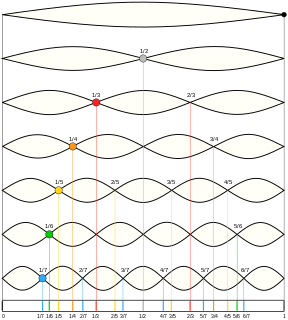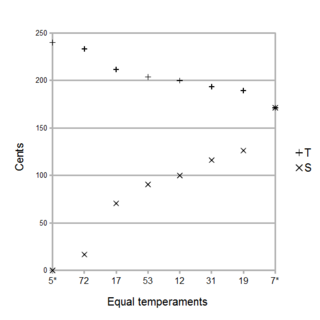
A harmonic is any member of the harmonic series. The term is employed in various disciplines, including music, physics, acoustics, electronic power transmission, radio technology, and other fields. It is typically applied to repeating signals, such as sinusoidal waves. A harmonic is a wave with a frequency that is a positive integer multiple of the frequency of the original wave, known as the fundamental frequency. The original wave is also called the 1st harmonic, the following harmonics are known as higher harmonics. As all harmonics are periodic at the fundamental frequency, the sum of harmonics is also periodic at that frequency. For example, if the fundamental frequency is 50 Hz, a common AC power supply frequency, the frequencies of the first three higher harmonics are 100 Hz, 150 Hz, 200 Hz and any addition of waves with these frequencies is periodic at 50 Hz.
An nth characteristic mode, for n > 1, will have nodes that are not vibrating. For example, the 3rd characteristic mode will have nodes at L and L, where L is the length of the string. In fact, each nth characteristic mode, for n not a multiple of 3, will not have nodes at these points. These other characteristic modes will be vibrating at the positions L and L. If the player gently touches one of these positions, then these other characteristic modes will be suppressed. The tonal harmonics from these other characteristic modes will then also be suppressed. Consequently, the tonal harmonics from the nth characteristic modes, where n is a multiple of 3, will be made relatively more prominent.

Meantone temperament is a musical temperament, that is a tuning system, obtained by compromising the fifths so that their ratio is slightly less than 3:2, in order to push the major thirds closer to a 5:4 ratio. Meantone temperaments are constructed the same way as Pythagorean tuning, as a stack of equal fifths.
A music sequencer is a device or application software that can record, edit, or play back music, by handling note and performance information in several forms, typically CV/Gate, MIDI, or Open Sound Control (OSC), and possibly audio and automation data for DAWs and plug-ins.

In music theory, the wolf fifth is a particularly dissonant musical interval spanning seven semitones. Strictly, the term refers to an interval produced by a specific tuning system, widely used in the sixteenth and seventeenth centuries: the quarter-comma meantone temperament. More broadly, it is also used to refer to similar intervals produced by other tuning systems, including most meantone temperaments.

GarageBand is a line of digital audio workstations for macOS, iPadOS, and iOS devices that allows users to create music or podcasts. GarageBand is developed by Apple for macOS, and was once part of the iLife software suite, along with iMovie and iDVD. Its music and podcast creation system enables users to create multiple tracks with pre-made MIDI keyboards, pre-made loops, an array of various instrumental effects, and voice recordings.

ChucK is a concurrent, strongly timed audio programming language for real-time synthesis, composition, and performance, which runs on Linux, Mac OS X, Microsoft Windows, and iOS. It is designed to favor readability and flexibility for the programmer over other considerations such as raw performance. It natively supports deterministic concurrency and multiple, simultaneous, dynamic control rates. Another key feature is the ability to live code; adding, removing, and modifying code on the fly, while the program is running, without stopping or restarting. It has a highly precise timing/concurrency model, allowing for arbitrarily fine granularity. It offers composers and researchers a powerful and flexible programming tool for building and experimenting with complex audio synthesis programs, and real-time interactive control.

A tangible user interface (TUI) is a user interface in which a person interacts with digital information through the physical environment. The initial name was Graspable User Interface, which is no longer used. The purpose of TUI development is to empower collaboration, learning, and design by giving physical forms to digital information, thus taking advantage of the human ability to grasp and manipulate physical objects and materials.

New Interfaces for Musical Expression, also known as NIME, is an international conference dedicated to scientific research on the development of new technologies and their role in musical expression and artistic performance.

In music, 31 equal temperament, 31-ET, which can also be abbreviated 31-TET or 31-EDO, also known as tricesimoprimal, is the tempered scale derived by dividing the octave into 31 equal-sized steps. Play (help·info) Each step represents a frequency ratio of 31√2, or 38.71 cents.

In music, 19 equal temperament, called 19 TET, 19 EDO, or 19 ET, is the tempered scale derived by dividing the octave into 19 equal steps. Each step represents a frequency ratio of 19√2, or 63.16 cents.

In musical tuning and harmony, the Tonnetz is a conceptual lattice diagram representing tonal space first described by Leonhard Euler in 1739. Various visual representations of the Tonnetz can be used to show traditional harmonic relationships in European classical music.

Generalized keyboards are musical keyboards, a type of isomorphic keyboard, with regular, tile-like arrangements usually with rectangular or hexagonal keys, and were developed for performing music in different tunings. They were introduced by Robert Bosanquet in the 1870s, and since the 1960s Erv Wilson has developed new methods of using and expanding them, proposing keyboard layouts including any scale made of a single generator within an "octave" of any size.

A hydraulophone is a tonal acoustic musical instrument played by direct physical contact with water where sound is generated or affected hydraulically. The hydraulophone was described and named by Steve Mann in 2005, and patented in 2011. Typically, sound is produced by the same hydraulic fluid in contact with the player's fingers. It has been used as a sensory exploration device for low-vision individuals.

A regular diatonic tuning is any musical scale consisting of "tones" (T) and "semitones" (S) arranged in any rotation of the sequence TTSTTTS which adds up to the octave with all the T's being the same size and all the S's the being the same size, with the 'S's being smaller than the 'T's. In such a tuning, then the notes are connected together in a chain of seven fifths, all the same size which makes it a Linear temperament with the tempered fifth as a generator.
An isomorphic keyboard is a musical input device consisting of a two-dimensional grid of note-controlling elements on which any given sequence and/or combination of musical intervals has the "same shape" on the keyboard wherever it occurs – within a key, across keys, across octaves, and across tunings.
Dynamic Tonality is a new paradigm for music which generalizes the special relationship between just intonation and the harmonic series to apply to a wider set of pseudo-just tunings and related pseudo-harmonic timbres.

In music, 17 tone equal temperament is the tempered scale derived by dividing the octave into 17 equal steps. Each step represents a frequency ratio of 17√2, or 70.6 cents.

The Wicki–Hayden note layout is a compact and logical musical keyboard layout designed for concertinas and bandoneons.

The Harmonic Table note-layout, or tonal array, is a key layout for musical instruments that offers interesting advantages over the traditional keyboard layout.

In computing, scratch input is an acoustic-based method of Human-Computer Interaction (HCI) that takes advantage of the characteristic sound produced when a finger nail or other object is dragged over a surface, such as a table or wall. The technique is not limited to fingers; a stick or writing implements can also be used. The sound is often inaudible to the naked ear. However, specialized microphones can digitize the sounds for interactive purposes. Scratch input was invented by Mann et al. in 2007, though the term was first used by Chris Harrison et al.
















